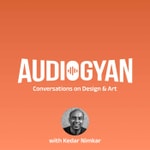The Gyaan Project – Details, episodes & analysis
Podcast details
Technical and general information from the podcast's RSS feed.

The Gyaan Project
The Gyaan Project
Frequency: 1 episode/10d. Total Eps: 313

www.thegyaanproject.com
Recent rankings
Latest chart positions across Apple Podcasts and Spotify rankings.
Apple Podcasts
No recent rankings available
Spotify
No recent rankings available
Shared links between episodes and podcasts
Links found in episode descriptions and other podcasts that share them.
See all- https://ivm.today/android
4087 shares
- https://ivm.today/ios
3005 shares
- http://www.ivmpodcasts.com/
2097 shares
- https://twitter.com/nimkarkedar
86 shares
- https://twitter.com/audiogyan
86 shares
- https://twitter.com/nimkarkedar?s=21
44 shares
RSS feed quality and score
Technical evaluation of the podcast's RSS feed quality and structure.
See allScore global : 59%
Publication history
Monthly episode publishing history over the past years.
Ep. 305 - Become a book cover designer with Ahlawat Gunjan
Season 8 · Episode 305
mardi 8 octobre 2024 • Duration 34:33
What goes into making a book cover design? The secrets of book publishing include what goes into making a book, the future of physical books in the digital world, and a few tips if you wish to get into editorial design or publication.
This is a public episode. If you would like to discuss this with other subscribers or get access to bonus episodes, visit www.thegyaanproject.com
Ep. 304 - Design & Furniture Systems with Andre Eckholt
mardi 1 octobre 2024 • Duration 41:11
This episode is for Interior Designers, Architects, and allied work streams. We’ll try and understand Design trends or innovations in the furniture landscape, how Hettich incorporates eco-friendly practices and materials, and of course, how do they support designers in implementing their visions within the systems framework.
Andre Eckholt joins us on Audiogyan. He is the managing director of a German lifestyle brand, Hettich.
This is a public episode. If you would like to discuss this with other subscribers or get access to bonus episodes, visit www.thegyaanproject.com
Ep. 295 - Woman Graphic Designers with Ruchita Madhok
mardi 21 mai 2024 • Duration 01:10:49
Tune into this 7th episode of a 10-part series, "Designer’s Digest” with Ruchita Madhok. Audiogyan creates this series in partnership with @godrejdesignlab
Designer's Digest series is about Design as a profession, its daily grind, the secrets to climbing the design career ladder, and what edge we’ll need to thrive in the captivating design world.
Ruchita has been a guest on episode 159, named “Designing a Visual Guide”. The poetry of everyday life inspires her. Through the mediums of cyanotype printmaking and drawing, she explores the conversations between nature, the cosmos, and the inner self. An award-winning communication designer, Ruchita brings a passion for print, photography, and illustration to her work as she plays with words and images to create works of art, books, and zines. Ruchita is the Founder and Director of Kahani Designworks and built Storycity, Imaginative books, maps, and guides for curious people.
We talk about what it means to be a graphic designer, in India, as a woman, and how you grow as a designer, many things to unpack.
Questions
- Who is a graphic designer? What's the job? You engage yourself in Poetry, Literature, and many other things beyond design. How critical it is for any creative endeavor?
- How do you see growth in this discipline? What does an entry-level designer do in Graphic Design? A person with 30-40 years of experience like Paula Scher or Milton Glaser - Will they be still hands-on like a performing artist? How do you see the graphic design career ladder?
- I understand that Design has many aspects, including communication, solving problems, and more… Particularly in graphic design, it’s communication, right? What is making you move (or have moved you) from Graphic Design and infographics to ‘art’ and more niche sort of storytelling? Why have you started exploring cyanotype printmaking and more?
- Kahani Studioworks and StoryCity believe in collaboration? Do you hire? What do you seek in people with whom you hire or collaborate?
- How does your trio identity as an Indian woman, a designer, and now an artist influence your artistic style and perspective?
- Do you see a distinct thread running through your work that speaks about your Identity or Indian-ness? How do you harness it to give it a personality or avoid it stereotyping your work? What would you share as a tip/advice for young designers?
- Do you think your design work / or art needs to impact society? Should it influence fellow and young designers? You have been taking a lot of workshops and are interested in education. Tell me a little bit about it?
- Ethical practices and sustainable design choices are now becoming mainstream buzzwords. Where are you on that and what are your principles in this dynamic world of Graphic Design?
- In today's digital age, where people have been looking to increase the number of followers on social media, what advice would you give to Indian Designers (especially women)? What do they chase? What can make their work stand out or be impactful in this noisy world? How long can it take to find one’s voice?
- The design field is vast and multifaceted. How would you encourage Indian women designers to explore their unique strengths and passions to find their niche within the industry?
References
- https://www.instagram.com/ruchitamadhok/?hl=en-gb
- https://www.ruchitamadhok.com/
- https://www.linkedin.com/in/ruchitamadhok/?original_referer=https%3A%2F%2Fwww.google.com%2F&originalSubdomain=in
- https://www.behance.net/ruchita
- https://www.kahanidesignworks.com/
- https://homegrown.co.in/homegrown-creators/ruchita-madhoks-botanical-cyanotypes-are-vibrant-interpretations-of-the-poetry-of-light
- https://audiogyan.com/2020/01/22/ruchita-madhok/
- https://www.storycity.in/
This is a public episode. If you would like to discuss this with other subscribers or get access to bonus episodes, visit www.thegyaanproject.com
Commitment to Kashmir with Devika Krishnan (ACS)
mardi 8 décembre 2020 • Duration 01:05:22
Crafts is an integral part of experiential creativity and the conduit for imagination of forms.
Today I have Devika Krishnan with us on Audiogyan; She is a founder of Studio sattva and Arthouse. Devika graduate in ceramics from NID and did MBA from ISB —- and since then has been working relentlessly in varied areas of design and empowerment. She continues to work for Dastkar Ranthambhore where she trains new groups of artisans. One of the topics which we will be discussing in this episode is her path-breaking project called Commitment to Kashmir that is enabling young and eager Kashmiris to set up their crafts businesses – with suitable market linkages – to sustain themselves and those they employ.
Questions
- Real India is 60%+ villages. Can you give us a sense of the broad landscape of arts and craft in our country?
- After working for more than 2 decades in this space, especially at Ranthambore, what are the insights you can share w.r.t crafts?
- Why is Kashmir so fertile when it comes to Crafts?
- What is commitment to Kashmir? How does it work? On which criteria these artisan are handpicked?
- What are the top 3 or 5 challenges which Kashmiri Artisians are facing?
- What all changes happened due to 370 in Kashmir?
- It is so juxtaposition that, Mumbai is financial capital of India and also house to biggest slum in Asia. Similarly, Kashmir being area of dispute and terror for nearly 7 decades and yet most beautiful when it comes to design and art. How do you reconcile this thought?
- Can you tell us which are the really unique indigenous products produced from Kashmir and why?
This is a public episode. If you would like to discuss this with other subscribers or get access to bonus episodes, visit www.thegyaanproject.com
Ep. 204 - Synthesis of standardisation with Neelkanth Chhaya
mardi 1 décembre 2020 • Duration 56:30
Prof. Neelkanth Chhaya - Architect, academician, and thinker, Neelkanth Chhaya has researched and worked extensively in the domain of appropriate architecture for India. He has documented places of historic significance and authored numerous critical papers. He retired in 2013 as the Dean of the Faculty of Architecture, at CEPT, Ahmedabad after a 24-year teaching sojourn at the School.
Before we begin, a quick shout out to Ruturaj Parikh from Matter in Goa for introducing me to these brilliant minds from the world of architecture and education. I also wanna say hi to Ayaz Basrai whom i interviewed in episode number 104 and he recommended documenting Prof. Neelkanth.
Questions
- What according to you is standardization? Where all do you see it happening? Do you see it happening in Architecture? Do you see it happening in design at large?
- It is said, standardization and process bring scale - How true it is in design? How important is scale for a developing country like us? Are we trapped in a cycle now?
- Does standardization kills diversity, ingenuity? What according to you is the biggest tradeoff of bringing standardization in design as a discipline?
- You have been an educator for more than 40 years. Education system is designed to meet demands of the market. Market demands profit. Profit can be achieved only through scale. Can one scale without standardization?
- Do you envision further standardization 50 years from now?
http://www.ceptarchives.org/Peoples/neelkanth-chhaya
https://architexturez.net/doc/az-cf-123851
https://www.acedge.in/courses/in-conversation-b-v-doshi-and-neelkanth-chhaya
https://www.architecturetalk.org/home/87chhaya
https://thinkmatter.in/tag/neelkanth-chhaya/
https://www.youtube.com/watch?v=XaSl_rFYsUc
https://www.youtube.com/watch?v=DFE0nVG2gKs
https://www.youtube.com/watch?v=T_p-C4k7Ip0
This is a public episode. If you would like to discuss this with other subscribers or get access to bonus episodes, visit www.thegyaanproject.com
Travel Writing with Shivaji Das
mardi 24 novembre 2020 • Duration 49:48
Today I have, a Writer, traveller, and photographer; Shivaji Das with us on Audiogyan. He has authored few books like, ‘Off the Beaten Track: Collecting Stories of Unheard Lives,’ ‘Journeys with the caterpillar: Travelling through the islands of Flores and Sumba, Indonesia,’ and most recently, "The other Shangri-la".
Shivaji’s writings and work with migrants have been published in journals such as TIME, The Economist, BBC and more... He was born and brought up in the north-eastern province of Assam and now stays in Singapore. Today we are here to discuss about travel writing as a practice or as a profession. Lets find out.
Questions
- What is different about travel writing? The way we have articles, opinions, factual documentation etc...What sort of sub sections do you have in travel writing? Are there any broad rules for them. For eg: Fiction can not have factual information etc...?
- I have heard this phrase called ego travel. What does it mean to you? In one of your articles you mentioned, you know when to be honest about the various fears and phobias you are attempting to overcome. Can you please elaborate on that with any example?
- Do you write about people or places? What is your definition of a place / destination? Is it the people or the geographical location or the cultural found within? Tell us more about "The other Shangri-la". Do you have any favorite experiences/destinations that was most gratifying?
- The advancement in modes of travel has made it easier to travel to the unreachable places. What have we gained and what have we lost in this transition?
- With new media coming, how and where does writing fit in this visual world of Youtube and IGTV? What's next with you? and what would be your 2 cents for those who wish to get into travel writing?
Reference
- https://www.amazon.in/OTHER-SHANGRI-Journeys-Sino-Tibetan-frontier/dp/8194201861/ref=sr_1_1?crid=1H709Q2BFCNXC&dchild=1&keywords=the+other+shangri-la&qid=1606239689&sprefix=the+other+she%2Caps%2C271&sr=8-1
- https://www.shivajidas.com
- https://asia.nikkei.com/Life-Arts/Arts/Seeking-magic-in-China-s-other-Shangri-La
- https://www.scmp.com/week-asia/opinion/article/3107642/chinas-lost-queendom-beauty-contests-and-love-triangles-endure
- https://www.outlookindia.com/outlooktraveller/explore/story/47039/offbeat-cruise-singapore-to-hong-kong
- https://theprint.in/pageturner/excerpt/indian-chinese-couple-went-on-a-road-trip-to-chengdu/487420/
- https://www.businesstimes.com.sg/lifestyle/weekend-interview/shivaji-das
- https://twitter.com/shivajiauthor?lang=en
- https://www.linkedin.com/in/shivaji-das-073611/?originalSubdomain=sg
- https://www.amazon.com/Shivaji-Das/e/B00EMT7GYS%3Fref=dbs_a_mng_rwt_scns_share
This is a public episode. If you would like to discuss this with other subscribers or get access to bonus episodes, visit www.thegyaanproject.com
Ep. 202 - Value centered design in Digital space with Navneet Nair
Season 4 · Episode 202
mardi 17 novembre 2020 • Duration 51:15
Daniel Kahneman in his book, "Thinking fast and slow", mentions that people are innately irrational when it comes to making decisions. Same goes with how they consume everyday products. In the book "Design of everyday things" Don Norman speaks about how people blame themselves if they are not able to pull the drawer rather than blaming the designer. Well, there definitely seems to be a pattern. Lets explore few of them and more importantly a designers role in this setup.
Being a Digital product designer myself, I have few insights. But to know more, today I have Navneet Nair with us on Audiogyan. Navneet is Head of Design at PhonPe. For the last two decades, he has been a hands-on practitioner of design and user focussed creative arts. Navneet has worked in both individual contributor roles and in leadership positions at startups and established companies like Yahoo & Google.
Questions
- How big or small role does design play in today's Indian startup ecosystem?
- You have spoken about the irrational user. Tell us more about it. How have you translated those learnings in your projects, at Google, yahoo or even now in PhonePe?
- You speak about value centered design. Can you tell us in detail what do you mean? Are there any best practices which you have implemented at Phonepe? How effective it has been?
- If you had to teach designers, either economics or being a full stack designer - what would you choose and why?
- Know the rules to bend the rules - What has been your experience while dealing with budding designers who come from user centered school of thought? How can they develop value centered design approach?
Reference Links
- http://www.navneetnair.com
- https://thehardcopy.co/navneet-nair-director-of-product-design-phone-pe-makes-a-recommendation/
- https://www.youtube.com/watch?v=Yb_rOlMi4Po&feature=emb_title
- https://navneetdesigns.medium.com
This is a public episode. If you would like to discuss this with other subscribers or get access to bonus episodes, visit www.thegyaanproject.com
Ep. 204 - Designing temples with A Srivathsan
mardi 10 novembre 2020 • Duration 50:31
Dr. A. Srivathsan is an architectural scholar with more than twenty-five years of experience in teaching, architectural and developmental research, and professional practice. Before joining his role as the Executive Director of CAU, Srivathsan served as the Academic Director of CEPT University for five years. He holds a Ph.D. from the Indian Institute of Technology along with a Master’s degree in Urban Design, School of Planning and Architecture, New Delhi. Today we are here to document how are contemporary sacred spaces designed, mainly the Hindu temples.
I also want to thank Ruturaj Parikh from Matter for making this episode happen.
- What is different about designing a sacred space? Are sacred places of worship built or they grow organically? Should such spaces be designed? Are sacred spaces like public spaces, or are they different?
- What is the relation between sacredness and architecture? Does specific kind of architectural forms and style have sacred quality? What is the role of Vast Sastra in this? If you can also tell, which tools they used to build these old architecture of temples?
- What role does an architect play in building temples? If the stapatis or sompuras are the traditional architects and experts in designing temples, do you need modern architects?
- Most of the temples have an ornamental look. Why so? Do ornamentation and decor continue in recent temples?
- What role do architects play in the modern context when they are designing temples? Do you have any insights to share about the architecture of the new Ram Mandir?
- How do you envision the design of sacred places of the future?
This is a public episode. If you would like to discuss this with other subscribers or get access to bonus episodes, visit www.thegyaanproject.com
”Painter of people” with Sudhir Patwardhan (200 EP)
mardi 3 novembre 2020 • Duration 50:12
This is the 200th episode of Audiogyan. Today I have Sudhir Patwardhan with us on Audiogyan. I celebrated 100th episode with India's design Hero, B.V. Doshi, and I am equally thrilled and excited to celebrate this 200th episode with another legend - Sudhir Patwardhan - one of India’s finest painters. Thank you Sudhir sir for giving your time and it's a real honor to have you on Audiogyan.
Questions
- Most legendary musicians talk about having emptied the mind to reach a higher state of consciousness while performing (Bismillah Khan or Kumar Gandharva). Is this the same process while painting? A painter seems to be filled with thoughts, contradictions, and conflicts in the world.
- Your early works (70's) were just the subject. Later on, you started bringing in context along with the subject. Why? What made you make this shift? Eventually, your paintings become busier. Why?
- You've said, “It is about what is possible to communicate and what is not. The artist starts by saying something, then he wipes and starts anew.” - Is this the reason why Mumbai has always inspired you? Even Mumbai gets washed with every wave hitting the island and starts fresh? Why Mumbai?
- This maximum city is transmuting rapidly all the time. How did you pick subjects to paint? Be it "corporate towers threatening to take over the long-defunct mills" or be it "riots". How did/do you handle the anxiety of expressing these equally burning issues and yet making it an iconic piece of art? (Is that how your multiple scenes within the same canvas emerge?)
- In my understanding, be it Vijay Tendulkar, or Satyajit Ray or you (For eg: "Paying the bill" painting - people next door, a common man, are subjects of your interest. What do you think makes your work so relatable? How come the common man (most of the time) is non-cognizant about it? R.K. Laxman could be an exception, maybe :)
- Human forms in your painting are doing mundane activities. Yet they are imbued with a sense of innate dignity as they go about performing their chores. What is transpiring in your expression?
- Your work ‘Citing the city’ at Sakshi Gallery in 2007 created a dialogue with society - How do you see these dialogues reaching the masses when the galleries are visited by the elite?
- You have been drawing Mumbai tirelessly. Crowded and chaotic scenes seem to be clearly depicted in your work. If you have to start all over again, which city would you pick?
This is a public episode. If you would like to discuss this with other subscribers or get access to bonus episodes, visit www.thegyaanproject.com
Brands and brand building with Karno Guhathakurta
mardi 27 octobre 2020 • Duration 55:17
This episode is brought to you by MUBI, a curated streaming service showing exceptional films from around the globe.
Every day, MUBI premieres a new film. Whether it's a timeless classic, a cult favorite, or an acclaimed masterpiece — a movie you’ve been dying to see or one you’ve never heard of before — there is always something new to discover.
Try MUBI free for 30 days at MUBI dot com, slash Audiogyan, that’s MUBI.com/audiogyan for a whole month of great cinema for free.
The concept of brand was once very simple. The word “brand” came from an Ancient Norse word “Brandr” meaning ”to burn”. In 950 A.D., brand meant a burning piece of wood. And in 1300’s, it meant a “torch” which was still meaning a burning piece of a wood used as a tool. In 1500’s, it meant a marked burned on cattle when farmers used to distinguish their cattle from cattle from other ranches.
In early 1800s, mass production, products like wine started to flourish and sellers started to use the word brand to imply leaving a mark into the crates. Products with better quality and high value naturally became known as a high-end products. In 1870, it finally became possible to register a trademark, and Coca Cola facilitated this to advertise their slogan “Coca Cola Revives and Sustains”.
Why am I talking about brands? Today I have Karno Guhathakurta with us on Audiogyan. He is a Creative director as Please-See agency which has designed numerous brands. They have done brand building for Foodhall, LazyPay, Mami and many more.
We'll try and get some insights behind brand building and discuss MAMI logo in the later half of the episode..
Thanks Korno for giving your time and it'e a real pleasure to have you on Audiogyan. Welcome.
Questions
- What according to you is branding (brand building) and what is a brand? What do these things comprise of, theoretically and practically in real life?
- What is easy to brand, a product or a service? How long does it take to brand a product or a service?
- Is Logo a brand? Can brands be made without advertising? (Can take examples to explain) Can a well-designed logo with a great product become a brand without marketing or Advertising? Any examples if you can share?
- If every branding, marketing, and advertising person must have seen Simon Sinek's golden circle, why do they still continue the opposite way?
- You and your team have done brand building for Foodhall, LazyPay, Mami, and many more. I am particularly interested in MAMI. Can you tell us the process in detail? from graphic to type selection to organic evolution of the logo?
- How and why did you arrive at what is in the public domain today? What were few options and how did it got finalized?
- Did Jio come a disrupt the form? (non-metaphorically. :) ) Do you think of sub-brands and taking over of bigger brands while designing logos?
- With a world where long tail are becoming brands themselves, what is your reading of how brands will evolve in the next 5 to 10 years?
Hope you enjoyed the show. MUBI India announced it's arrival at MAMI last year. Now to tell you a bit more about MUBI - it’s a film streaming service, showcasing the best of Indian cinema on their MUBI INDIA channel and classic international hits on MUBI WORLD with a new film every day on each channel.
This week I recommend watching Abhay Kumar's Placebo, Kamal K.M's I.D., Ashim Ahluwalia's Miss Lovely
You can watch this and more great cinema free for a whole month at MUBI.com/audiogyan
This is a public episode. If you would like to discuss this with other subscribers or get access to bonus episodes, visit www.thegyaanproject.com









